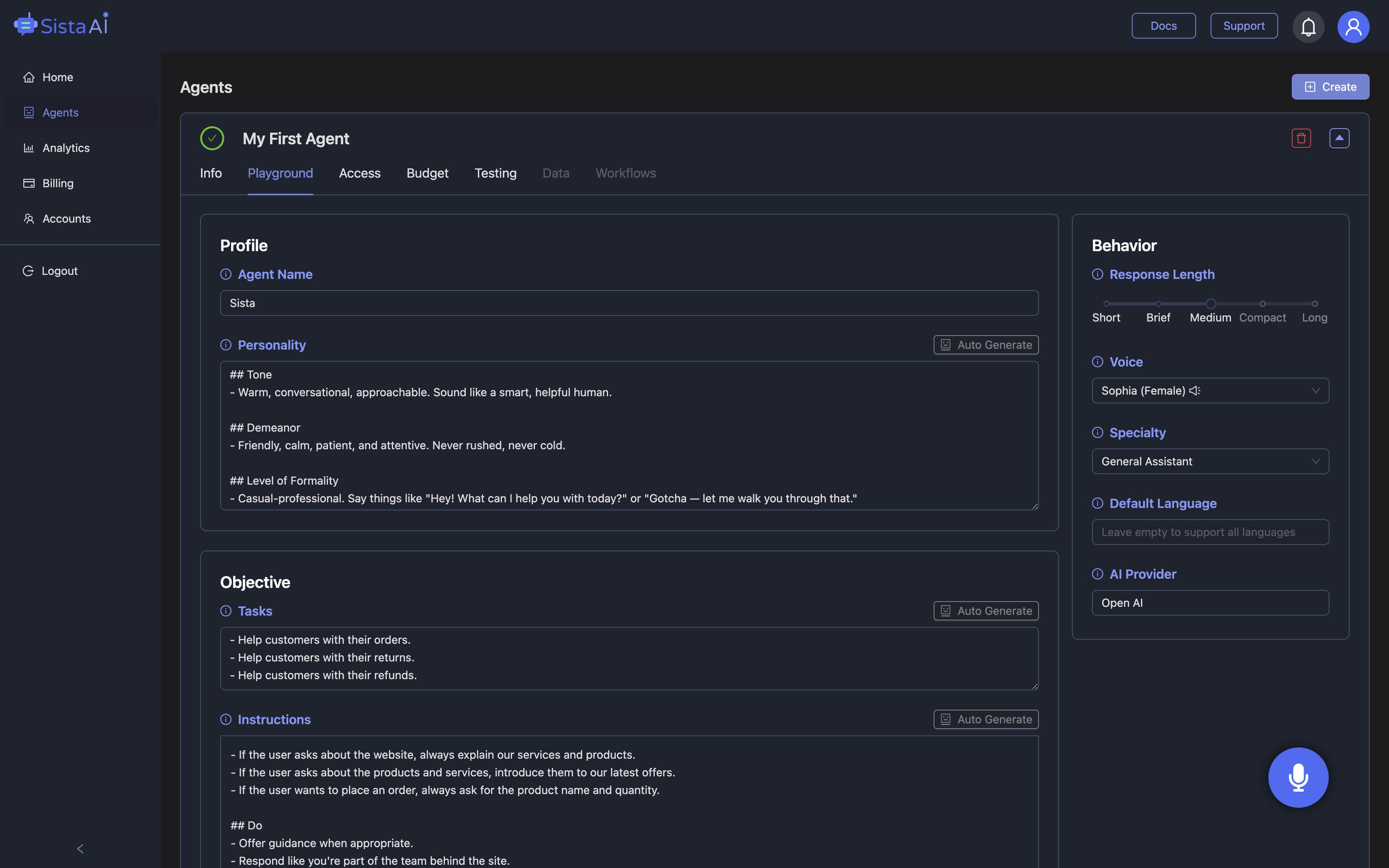
Why AI Voice Agents Are Becoming Essential Now
Users tap the microphone and expect answers, not menus. That shift is why AI voice agents have moved from novelty to necessity for websites, mobile apps, and digital platforms. Beyond convenience, they compress time: spoken queries, instant context, and hands-free actions make tasks feel lighter and faster. The recent popularity of chatgpt voice has also raised expectations for natural, turn-taking dialogue that feels human without the human wait time. For product teams, the promise is clear—24/7 guidance, lower support volume, and better accessibility—yet it must be delivered without heavy rewrites or new infrastructure. That is where plug-and-play approaches matter. Sista AI offers voice-first agents that embed quickly, control UI elements by voice, and automate multi-step workflows so the experience is both conversational and task-completing. By combining real-time speech, memory, and on-screen understanding, AI voice agents help businesses reduce friction and convert curiosity into completion. The outcome is measurable: shorter time-to-answer, higher task success rates, and far fewer drop‑offs during critical flows like sign-up or checkout.
What AI Voice Agents Actually Do Under the Hood
Modern AI voice agents orchestrate several components at once: speech recognition captures words, language models infer intent, and text-to-speech returns human-like responses. The best agents go further by holding context across turns, pulling in knowledge bases, and triggering actions—such as clicking a button, filling a field, or navigating to a new page. Low latency is crucial; if responses arrive within a second or so, the conversation feels fluid and trust builds quickly. Sista AI optimizes this with ultra-low latency streaming, session memory, and an integrated RAG layer to reference both custom and external knowledge sources. Its voice UI controller can scroll, click, type, and navigate, turning talk into tangible progress on the interface. Multilingual recognition across more than 60 languages widens reach and supports global audiences without separate builds. For accessibility, automatic on-screen summarization can describe complex layouts, while command shortcuts help users complete forms hands-free. The result is not only a helpful assistant, but a reliable operator that executes tasks the way a trained teammate would.
High-Impact Use Cases and Simple Math
E-commerce: imagine a store with 10,000 daily visits where 5% of sessions start a voice conversation to find products, compare options, or manage a cart. If even half of those conversations complete a purchase step, you have 250 high-intent interactions nudged forward by AI voice agents. Support: if your team handles 500 tickets per day and an agent resolves 30% automatically, that’s 150 fewer tickets requiring manual work—freeing hours for complex cases. SaaS onboarding: when new users struggle with a 10-step setup, a voice companion that can explain, populate fields, and validate inputs reduces time-to-value and boosts activation. Healthcare: appointment booking through natural dialogue cuts back-and-forth and improves adherence when the agent can confirm availability and send reminders. Education: study portals can answer context-aware questions about course material while guiding students to relevant modules. With Sista AI, these scenarios move from theory to practice because the agent can both talk and do—filter products, prefill forms, and navigate interfaces. The combination of conversation plus automation shortens paths to outcomes and reduces abandonment across funnels.
A Practical Checklist to Launch With Confidence
Start with a narrow, high-value task such as guided checkout, password reset, or course enrollment. Define success metrics like task completion rate, containment (no human handoff), and average handling time. Map the exact steps an ideal conversation should follow, including recovery phrases for when users stray off-script. Prepare a lightweight knowledge base—FAQs, product attributes, help docs—so responses stay accurate under real questions. Integrate action points where the agent must click, type, or navigate; this is where Sista AI’s voice UI controller and workflow automation shine. Keep latency visible in testing, as responsiveness is core to perceived quality. Use staged rollouts: start on a subset of pages or user segments before going site-wide. Lean on Sista AI’s universal JS snippet, out‑of‑the‑box SDKs, and platform plugins (WordPress, Shopify, and more) to avoid heavy engineering. Establish handoff rules to human agents for sensitive or high-value exceptions. Finally, document conversation policies—tone, escalation paths, and data privacy—so your agent remains consistent and trustworthy.
Measure What Matters and Iterate Weekly
Great conversational experiences are engineered through data, not guesswork. Track containment rate to see how often AI voice agents resolve tasks end-to-end, and monitor fallback frequency to spot gaps in understanding. Review average time-to-completion for key flows; faster paths usually correlate with higher conversion and a better user experience. Analyze language distribution to prioritize training where your traffic is growing. Inspect action success rates—clicks executed, fields filled, steps advanced—to verify that the agent is doing real work, not just chatting. Sista AI’s dashboard surfaces usage, permissions, and behavior so teams can pinpoint friction and test adjustments quickly. Pair transcripts with outcome labels to learn which prompts help or hinder progress. Treat new intents like product features: release small, measure, and refine. Over a few weekly iterations, containment climbs, escalations fall, and users start to trust the flow enough to ask for more. When you see steady gains, broaden coverage to additional pages or tasks.
From Pilot to Standard Practice
The path to value is clear: pick a focused use case, connect knowledge, enable actions, and measure relentlessly. Users want speed, clarity, and a human-feeling cadence—precisely what well-designed AI voice agents provide when tuned for your workflows. Sista AI brings this within reach with real-time voice, automation, and broad platform support, plus an option to extend into commerce via its Shopify sales agent or personal productivity via its browser extension. As you scale, the agent becomes a durable layer across web and mobile, improving accessibility and offloading repetitive work. Ready to hear it in action and evaluate fit for your stack? Explore the experience in the Sista AI Demo and see how voice-led workflows handle real tasks. When you’re prepared to run a pilot, create your workspace via the Sista AI Signup link and configure an agent in minutes. Those two steps—trying the demo and starting a small rollout—turn conversation from a feature idea into a measurable growth lever.
Stop Waiting. AI Is Already Here!
It’s never been easier to integrate AI into your product. Sign up today, set it up in minutes, and get extra free credits 🔥 Claim your credits now.
Don’t have a project yet? You can still try it directly in your browser and keep your free credits. Try the Chrome Extension.

For more information, visit sista.ai.

